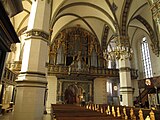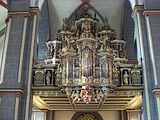Gottfried Fritzsche
Gottfried Fritzsche (sometimes spelled Frietzsch) (1578 – 1638) was a German organ builder.
Life
[edit]Gottfried Fritzsche[a] was born in Meissen in 1578.[2] He was the son of goldsmith Jobst Fritzsche (died 1585), and began his professional life learning and working in his father's craft.[3] His grandfather Johannes Fritzsche (1508-1586) was cathedral syndic in Meissen.[citation needed]
Before 1603 Fritzsche probably learned organ building from Johann Lange (sometimes given as Hans Lange)[2] in Kamenz.[3] Fritzsche was an organ builder in Meissen from 1604[3] until 1612 when he relocated to Dresden.[2] There he was appointed court organ builder to the Elector of Saxony around 1614.[4] From 1619 to 1627, he worked in Wolfenbüttel and from 1628 to 1629 in Celle, before coming to Ottensen in 1629.[3] He succeeded Hans Scherer the Younger in Hamburg upon Scherer's death in 1631, taking over the Scherer family's organ business.[5] He remained there until his death in 1638.[2]
His first marriage to a woman who is no longer known by name produced three sons and three daughters, including the organ builder Hans Christoph Fritzsche. Through his second marriage in 1629 to Margarete née Ringemuth, widowed Rist, he became the stepfather of the poet Johann Rist. His pupils (and later sons-in-law) were Friederich Stellwagen and Tobias Brunner.
Work
[edit]Fritzsche stood on the threshold from the Renaissance to the early Baroque. He further developed Brabant organ building and introduced numerous innovations,[1] for example, on the Zungenregister the rackett regals such as dulzian, regal, sordun and the long-beaked crumhorn. Fritzsche not infrequently placed stops of the same stop family but with contrasting scales (wide and narrow) in one work or chose unusual foot pitches. In the Brustwerk and pedal he regularly used one-foot voices, which were still unknown with Scherer.[6] Also characteristic is his double zill, which takes the place of Scherer's high-lying Scharff, as well as the use of various aliquotregister as single voices. For example, the simbel installed by Fritzsche in 1635 in the organ of the St. James' Church, Hamburg was the first of its kind in northern Germany. He also liked to use secondary stops such as tremulant and "drum", which do not yet appear in Scherer's work, and Effect stops such as "Cuckoo", "Birdsong", and "Nightingale".[7] While hammered lead pipes had been the rule in northern Germany until then, Fritzsche planed the pipes and used an alloy with a higher tin content; for the cups of the trombones and trumpets he added marcasite. Compared to Scherer, the use of Subsemitones (double upper keys) was new. During his time in Hamburg, he carried out alterations to the organs of all four main churches. Fritzsche's extensions made the organs in St. Jacobi and St. Katharinen among the first organs ever to have four manuals.[8]
Fritzsche died in Ottensen, modern-day Hamburg.
List of work
[edit]| Year | Location | Church | Picture | Manual | Stops | Notes |
|---|---|---|---|---|---|---|
| 1603 | Meissen | Meissen Cathedral | II/P | 17 | Swallow's nest organ; destroyed by lightning on 27 April 1647.[9] | |
| 1609–1610 | Meißen | Frauenkirche | not preserved | |||
| 1612–1614 | Dresden | Schlosskapelle |  | II/P | 33 | in collaboration with Hans Leo Hassler; transferred to St. Matthew's Church in 1737; not preserved; disposition by Michael Praetorius: Syntagma Musicum. Vol. 2: De Organographia[10] |
| 1615–1617 | Sondershausen | Trinitatiskirche | II/P | 33 | Burnt in 1621 | |
| 1617 | Wolfenbüttel | St. Trinitatis |  | II/P | 21 | Originally built for the castle chapel Schöningen; transferred and rebuilt in 1722/23; façade preserved much altered |
| 1618–1619 | Bayreuth | Stadtkirche | II/P | 35 | not preserved | |
| 1621–1622 | Harbke | St. Levin |  | I/P | 18 | Addition of a rückpositiv by Christoph Treutmann in 1728; front and pipe material preserved.[11] |
| 1619–1623 | Wolfenbüttel | Marienkirche |  | III/P | 39 | Reconstructed front and 6 stops preserved |
| 1621–1623 | Braunschweig | St. Katharinen | III/P | 6 stops preserved and integrated in the new building by Rudolf von Beckerath Orgelbau (1980) | ||
| 1622–1625 | Clauen | Village church |  | I/p | Originally built for Wolfenbüttel Castle Church; rebuilt by Johann Andreas Graff in 1725/26; transferred to Clauen in 1796; baroque facade and parts of pipework and wind chests preserved; restored by Bernhardt Edskes in 1995 | |
| 1620er | Coswig | Alte Kirche |  | I | 9 | Builder unknown, possibly Frietzsch or Tobias Weller; moved to Coswig around 1735, repainted in 1760; preserved[12] → Orgel |
| 1626–1627 | Braunschweig | St.-Ulrici-Kirche | III/P | 26 | not preserved | |
| 1627 | Dresden? | I | 1 | Attribution; positiv with parchment pipes; today preserved in the Victoria and Albert Museum..[13] | ||
| 1629–1630 | Hamburg | Maria Magdalena | II/P | 23 | not preserved | |
| 1630 | Hamburg-Ottensen | Christianskirche | Extension conversion of an older organ; some stops taken over in 1744/1745 in new building by Johann Dietrich Busch. | |||
| 1630 | Hamburg | Ehemalige Hauptkirche Sankt Nikolai | Transfer from the space above the north door to a new gallery "under the tower in the west"; extension and conversion of unknown size.[14] | |||
| 1624–1631 | Torgau | Torgauer Schlosskapelle | not preserved | |||
| 1630–1631 | Braunschweig | St. Martini |  | II/P | 24 | Draft for a disposition, which Jonas Weigel executed in a modified form |
| 1632 | Hamburg | Hauptkirche Sankt Katharinen |  | IV/P | 56 | Extension reconstruction; Frietzsch pipes in four Brustwerk stops preserved; 2013 reconstruction of the state of 1720 (photo) |
| 1633–1634 | Hamburg | St.-Petri-Kirche | IV/P (three manuals) | Renovation, extension and conversion.[15] New: Brustwerk (attached to Oberwerk), all Rückpositiv stops, individual stops in Hauptwerk and pedal. New keyboards or extension of the manual range up to c3, with divided upper keys, sub-semitones, in all (linkable) manual keyboards for the additional notes dis, as und ais. Not preserved. | ||
| 1634 | Neuengamme | St. Johannis | I/P | 1803 by Johann Paul Geycke and later rebuilt several times; 5 stops complete and 6 partly preserved.[16] | ||
| 1634 | Altengamme | St. Nicolai | New building; replaced by Johann Dietrich Busch in 1751 | |||
| 1635–1636 | Hamburg | St.-Jacobi-Kirche | IV/P | 56 | Expansion to four manuals with a range of 4 octaves (in the Rückpositiv from dis° up to and including dis2 seven divided upper keys, subsemitones, for the additional notes dis, as and ais); during the new construction in 1693, Schnitger took over 20 stops from Frietzsch in varying ranges.[17] | |
| 1637 | Hamburg-Allermöhe | Dreieinigkeitskirche |  | New building; later rebuilt several times, front burnt in 1900.[18] | ||
| 1636–1638 | Trittau | 12 | remained unfinished.[19] | |||
| 1637–1638 | Borstel (Jork) | St. Nikolai | II/P | etwa 20 | Repair of the organ by an unknown builder (2nd half of the 16th century); organ rebuilt several times, intervened in 1770-1772 by Johann Paul Geycke, who also created a new casing; soundboards of two reed stops by Frietzsch preserved. |
Notes and references
[edit]Notes
[edit]References
[edit]- ^ a b Günter Seggermann; Alexander Steinhilber; Hans-Jürgen Wulf (2019). Die Orgeln in Hamburg. Kiel: Ludwig. pp. XVII. ISBN 978-3-86935-366-1.
- ^ a b c d Klotz, Hans; Kollmannsperger, Dietrich (2001). "Fritzsche, Gottfried". Grove Music Online. Oxford University Press. doi:10.1093/gmo/9781561592630.article.10295.
- ^ a b c d Schröder, Dorothea (2008). Orgeln und Orgelbau im Herzogtum Wolfenbüttel 1580-1650 (PDF). Kulturstadtverein Wolfenbüttel. p. 13. Archived from the original (PDF) on 2015-04-02. Retrieved 2021-02-20.
- ^ Pape: Lexikon norddeutscher Orgelbauer. Vol. 1. 2009, p. 81.
- ^ Klotz, Hans; Kollmannsperger, Dietrich (2001). "Scherer(i)". Grove Music Online. Oxford University Press. doi:10.1093/gmo/9781561592630.article.24809.
- ^ Fock: Hamburgs Anteil am Orgelbau. 1939, p. 345 (online, retrieved 21 February 2021.)
- ^ Fock: Hamburgs Anteil am Orgelbau. 1939, p. 346 (Online, retrieved 21 February 2021.)
- ^ Fock: Arp Schnitger und seine Schule. 1974, p. 43.
- ^ Gurlitt: Der Kursächsische Hoforgelmacher Gottfried Fritzsche. 1937, p. 109 (Gottfried Fritzsche at Google Books).
- ^ Praetorius: Syntagma Musicum. Vol. 2, p. 187 (online), retrieved 21 February 2021.
- ^ Orgel in Harbke, retrieved 20 February 2021.
- ^ "Webseite der Alten Kirche Coswig". Archived from the original on 2019-11-27. Retrieved 2021-02-20.
- ^ Fritzsche-Positiv, gesehen 1. Januar 2013.
- ^ Fock 1939, p. 347; Fock 1974, p. 46.
- ^ Schröder 2006, pp. 32–33.
- ^ Orgel in Neuengamme, Organ database.
- ^ Gustav Fock (1939). "Hamburgs Anteil am Orgelbau im niederdeutschen Kulturgebiet". Zeitschrift des Vereins für Hamburgische Geschichte (38): 351–352.
- ^ "Orgeltradition in Allermöhe". Archived from the original on 2013-12-17. Retrieved 2021-02-20.
- ^ Gurlitt: Der Kursächsische Hoforgelmacher Gottfried Fritzsche. 1937, S. 120 ([1], p. 120, at Google Books).
Further reading
[edit]- Ibo Ortgies: Gottfried Frietzschs Orgelbau in Hamburg: St. Catherine's Church, Hamburg und die Subsemitonien. In Ars Organi. 68, No. 3, 2020, pp. 146–156. (This article is a comprehensive update, amendment and extension of the article Gottfried Frietzsch and the Subsemitones in the Large Organ of Hamburg, St. Catherine’s. In Johann Norrback, Joel Speerstra und Ralph Locke (ed.): Festschrift for Prof. Kerala J. Snyder (GOArt Publications. Vol. 4). Göteborgs universitet, Göteborg 2019, 13 S. online (PDF: 1,8 MB)).
- Gisela Jaacks: Fritzsche, Gottfried. In Franklin Kopitzsch, Dirk Brietzke (ed.): Hamburgische Biografie. Vol. 5. Wallstein, Göttingen 2010, ISBN 978-3-8353-0640-0, pp. 20–120.
- Pape, ed. (2009). Lexikon norddeutscher Orgelbauer. Vol. 1: Thüringen und Umgebung. Berlin: Uwe Pape. pp. 81f. ISBN 978-3-921140-86-4.
- Dorothea Schröder (2006). Gloria in excelsis Deo. Eine Geschichte der Orgeln in der Hauptkirche St. Petri, Hamburg. Neumünster: Wachholtz. pp. 30–34. ISBN 978-3-529-02848-9.
- Wolfram Steude: Beobachtungen zur Funktion der Dresdner Fritzsche-Orgel im 17. Jahrhundert. In Matthias Herrmann (ed.): Wolfram Steude, Annäherung durch Distanz. Texte zur älteren mitteldeutschen Musik und Musikgeschichte. Klaus-Jürgen Kamprad, Altenburg 2001, pp. 97–102.
- Frank-Harald Greß: Die Gottfried-Fritzsche-Orgel der Dresdner Schloßkapelle. Untersuchungen zur Rekonstruktion ihres Klangbildes. In Acta Organologica. Vol. 23, 1993, pp. 67–112.
- Gustav Fock (1974). Arp Schnitger und seine Schule. Ein Beitrag zur Geschichte des Orgelbaues im Nord- und Ostseeküstengebiet. Kassel: Bärenreiter. ISBN 3-7618-0261-7.
- Gustav Fock (1939). "Hamburgs Anteil am Orgelbau im niederdeutschen Kulturgebiet". Zeitschrift des Vereins für Hamburgische Geschichte (38): 347.
- Hans Klotz (1961). "Fritzsche, Gottfried". Neue Deutsche Biographie (in German). Vol. 5. Berlin: Duncker & Humblot. p. 636. (full text online).
- Wilibald Gurlitt: Der Kursächsische Hoforgelmacher Gottfried Fritzsche. In Helmuth Osthoff, Walter Serauky, Adam Adrio (ed.): Festschrift Arnold Schering zum 60. Geburtstag. Reprint Georg Olms Verlag, Berlin 1937, pp. 106–124 (Gottfried Fritzsche at Google Books).
- Hans Klotz: Fritzsche, Gottfried. In Friedrich Blume (ed.): Die Musik in Geschichte und Gegenwart. Vol. 4, Bärenreiter, Kassel [among others] 1955, Sp. 978–982.
External links
[edit]- Christian Lobback: Hanseatischer Orgelbau im Licht des 21. Jahrhunderts, particularly the chapter Die Reformorgeln Gottfried Fritzsches
- Dorothea Schröder: Orgeln und Orgelbau im Herzogtum Wolfenbüttel 1580–1650 Archived 2015-04-02 at the Wayback Machine (PDF-Datei; 427 kB)


 French
French Deutsch
Deutsch